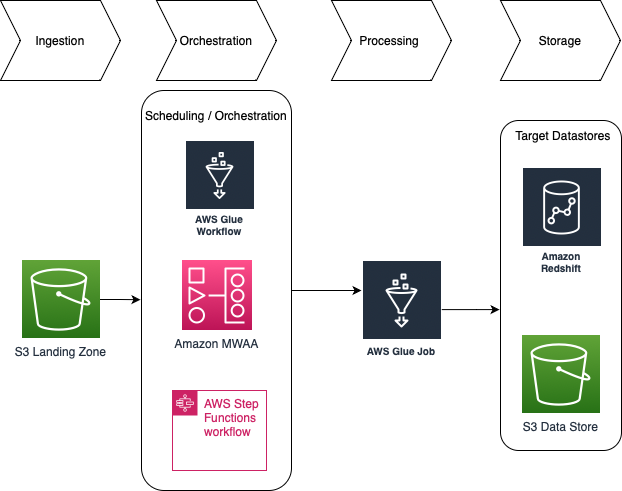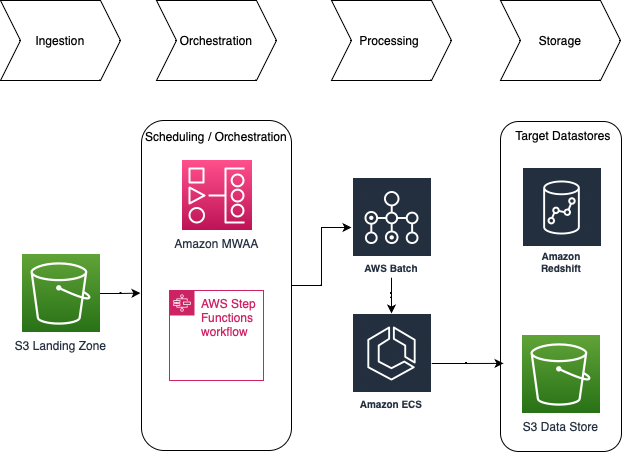Comparing Glue ETL and AWS Batch: Optimal Tool Selection for Data Transformation
Use this article to evaluate Glue ETL and AWS Batch to take advantage of the many opportunities that data-driven insights can bring.
Join the DZone community and get the full member experience.
Join For FreeAs we continue to delve deeper into the digital age, the importance of data continues to grow. Businesses, scientists, and governments alike are gathering increasingly vast amounts of information, and these datasets require sophisticated tools for processing and analysis. Two such tools that have gained significant attention recently are Amazon's AWS Glue ETL and AWS Batch services. Both offer robust functionalities for managing, transforming, and analyzing data, but how do you decide which is the best fit for your specific needs? In this article, we will take a detailed look at both AWS Glue ETL and AWS Batch, comparing their features, capabilities, and use cases to help you make an informed decision.
Overview
Data transformation tools play a crucial role in data analysis. They help in converting raw data into useful information that can be used for decision-making. The process involves cleaning, normalizing, and transforming raw data to prepare it for analysis. AWS Glue ETL and AWS Batch are among the top data transformation tools that are designed to handle these tasks, offering different capabilities and strengths based on the specific requirements of your workload.
AWS Glue ETL is a fully managed service that provides a serverless Apache Spark environment to run your Extract, Transform, Load (ETL) jobs. It is designed to prepare and load your data for analytics. Following is a reference architecture for Glue ETL.

On the other hand, AWS Batch is a service that makes it easy to run batch computing workloads on the AWS Cloud. It is designed to simplify batch operations, such as scientific simulations, financial modeling, image or video processing, and machine learning workloads. Following is a reference architecture for AWS Batch running transformation jobs.

Resource Management
AWS Glue ETL creates and manages the compute resources in your AWS account, giving you full control and visibility into the resources being used. It also allows you to scale up or down the resources based on the demand of your ETL jobs. AWS Glue ETL automatically provisions and manages the infrastructure required to create ETL jobs, allowing you to focus on writing and tuning your ETL code rather than managing resources.
Like AWS Glue ETL, AWS Batch also creates and manages the compute resources in your AWS account. It supports multi-node parallel processes, allowing you to run single jobs across several EC2 instances. AWS Batch dynamically provisions the optimal quantity and type of compute resources based on the volume and specific resource requirements of the batch jobs submitted, providing efficient resource utilization.
Both AWS Glue ETL and AWS Batch provide robust resource management features. However, the choice between these two tools depends on the nature of your workload. If your workloads involve ETL jobs and require a serverless Apache Spark environment, AWS Glue ETL would be more suitable. Conversely, if your workloads involve batch computing jobs that can be broken down into smaller, discrete units of work, AWS Batch would be more efficient.
Data Processing and Transformation
AWS Glue ETL is built to handle complex data transformations. It provides a visual interface to create, run, and monitor ETL jobs with ease. You can use AWS Glue ETL to catalog your data, clean it, enrich it, and move it reliably between various data stores. Additionally, AWS Glue ETL supports both batch and streaming ETL jobs, allowing you to process and transform data as it arrives or in batches, depending on your business needs.
AWS Batch enables developers, scientists, and engineers to easily and efficiently run hundreds of thousands of batch computing jobs. It provides support for multi-node parallel processes, which allow you to run single jobs across several EC2 instances. This feature is particularly useful for tightly-coupled HPC workloads. AWS Batch also offers priority-based job scheduling, enabling you to create several queues with various priority levels for your jobs.
While both AWS Glue ETL and AWS Batch offer robust data processing and transformation features, their efficiency depends on the specific needs of your workloads. AWS Glue ETL shines when dealing with ETL operations, while AWS Batch is more suited for running batch computing jobs. Therefore, understanding the nature of your workload is key to choosing the right tool.
Error Handling and Debugging
AWS Glue ETL provides comprehensive error handling and debugging capabilities. It logs all the events related to your ETL jobs and maintains these logs in CloudWatch, making it easier to debug issues. In case of errors during ETL operations, AWS Glue ETL reruns the jobs from the point of failure, ensuring that your jobs complete successfully.
AWS Batch provides detailed logging for your batch jobs using Amazon CloudWatch Logs. It also allows for the re-queueing of failed jobs, enabling them to be retried automatically. AWS Batch also provides an API operation to cancel jobs, giving you control over your batch workloads.
Both AWS Glue ETL and AWS Batch provide strong error handling and debugging features. The choice between the two again depends on the nature of your workload. If your workloads involve ETL operations, AWS Glue ETL's features, such as automated rerunning of failed jobs, could be more beneficial. If your workloads involve batch processing, AWS Batch's ability to re-queue failed jobs and cancel jobs via API could prove to be handy.
Scheduling and Automation
AWS Glue ETL provides robust scheduling and automation capabilities. You can schedule ETL jobs to run at specific times or in response to specific events. AWS Glue ETL also supports workflow orchestration, allowing you to design complex ETL workflows and automate their execution.
AWS Batch offers priority-based job scheduling, enabling you to create multiple queues with various priority levels. This feature allows you to prioritize the execution of your batch jobs based on their importance. AWS Batch also supports job dependencies, allowing you to specify that certain jobs depend on the successful completion of others. This feature enables you to automate complex workflows involving multiple interdependent jobs.
Both AWS Glue ETL and AWS Batch offer strong scheduling and automation capabilities. AWS Glue ETL provides more sophisticated workflow orchestration features, which can be beneficial if your workloads involve complex ETL operations. On the other hand, AWS Batch's support for job dependencies offers greater flexibility when dealing with interconnected batch jobs. On top of that, both Glue and Batch jobs can be scheduled externally using either Amazon Managed Workflow for Apache Airflow or Step Function providing greater flexibility.
Pricing and Plans
AWS Glue ETL pricing is primarily based on the number of Data Processing Units (DPUs) used by your ETL jobs. A DPU is a measure of processing capacity that consists of 4 vCPUs of compute capacity and 16 GB of memory. AWS Glue ETL charges you an hourly rate for each DPU hour used by your ETL jobs. In addition to DPU usage, AWS Glue ETL may also incur additional costs for data transfer and storage.
AWS Batch pricing is primarily based on the cost of AWS resources (like EC2 instances or AWS Fargate) used to run your batch jobs. There are no additional charges for using AWS Batch. You only pay for the AWS resources needed to store and execute your batch jobs.
Both AWS Glue ETL and AWS Batch offer excellent value for money, considering their robust features and capabilities. The choice between the two would primarily depend on your workload requirements and budget constraints. AWS Glue ETL might be a better choice if your workloads require complex ETL operations and you are willing to pay for the convenience of a fully managed service. On the other hand, AWS Batch could be a more cost-effective option for running large-scale batch jobs, as you only pay for the AWS resources you use.
Integration Options
AWS Glue ETL integrates seamlessly with various AWS services. It integrates with Amazon S3 for data storage, Amazon Redshift for data warehousing, and Amazon Athena for interactive query services. AWS Glue ETL also integrates with AWS Lake Formation, enabling you to build, secure, and manage data lakes with ease.
AWS Batch also offers robust integration options with other AWS services. It integrates with Amazon EC2 for compute resources, Amazon S3 for data storage, and Amazon CloudWatch for monitoring and logging. Additionally, AWS Batch integrates with AWS Step Functions, allowing you to orchestrate complex workflows involving multiple AWS Batch jobs and other AWS services.
Both AWS Glue ETL and AWS Batch provide seamless integration with other AWS services, making them ideal for building comprehensive data workflows on the AWS platform. The key difference lies in the specific services they integrate with. AWS Glue ETL's integration with data warehousing and query services like Amazon Redshift and Amazon Athena makes it particularly suitable for ETL workflows. Conversely, AWS Batch's integration with AWS Step Functions makes it ideal for orchestrating complex workflows involving multiple batch jobs and other AWS services.
Customer Support and Documentation
AWS offers extensive support and documentation for AWS Glue ETL. The AWS Glue ETL documentation provides detailed guides and tutorials to help you get started, understand key concepts, and learn best practices. In case of technical issues, you can reach out to AWS support through multiple channels, including forums, email, phone, and chat. AWS also provides professional services and training programs to help you make the most of AWS Glue ETL.
AWS offers similar support options and resources for AWS Batch. The AWS Batch documentation provides comprehensive guides and tutorials covering all aspects of the service. For technical assistance, you can contact AWS support via forums, email, phone, and chat. AWS also offers professional services and training programs specifically tailored for AWS Batch.
Conclusion
In conclusion, both AWS Glue ETL and AWS Batch are powerful tools for data transformation, each with its unique strengths. AWS Glue ETL excels in handling ETL operations and integrates well with data warehousing and query services. AWS Batch, on the other hand, shines in running batch computing jobs and orchestrating complex workflows.
Choosing the best data transformation tool depends on your specific needs and preferences. If you primarily deal with ETL operations and require a fully managed service that is simple, easy to use and integrates well with data warehousing and query services, AWS Glue ETL might be the optimal choice for you. On the other hand, if your workloads involve batch computing jobs needing more control over resource management, priority-based job scheduling, flexibility to run tightly-coupled HPC workloads, and the ability to orchestrate complex workflows, AWS Batch could be the ideal tool.
Opinions expressed by DZone contributors are their own.

Comments